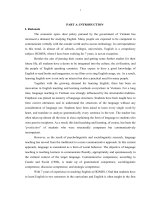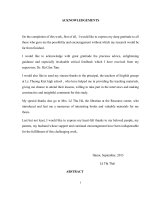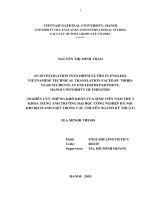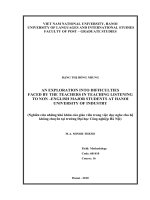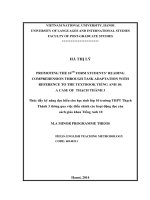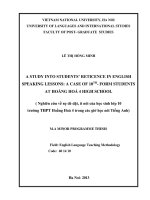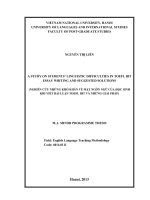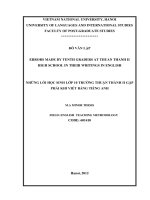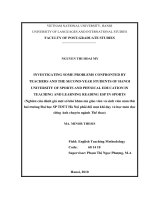Nghiên cứu những khó khăn mà giáo viên và học sinh khối mười trường THPT Nam Tiền Hải gặp phải khi triển khai các hoạt động theo cặp và nhóm trong giờ học nói
Bạn đang xem bản rút gọn của tài liệu. Xem và tải ngay bản đầy đủ của tài liệu tại đây (852.23 KB, 53 trang )
VIETNAM NATIONAL UNIVERSITY, HANOI
UNIVERSITY OF LANGUAGES & INTERNATIONAL STUDIES
Department of Post-graduate Studies
BUI THI BICH LIEN
AN INVESTIGATION ON DIFFICULTIES ENCOUNTERED BY THE
TEACHERS AND THE 10
TH
FORM STUDENTS AT NAM TIEN HAI HIGH
SCHOOL IN IMPLEMENTING PAIR WORK AND GROUP WORK IN
SPEAKING LESSONS
NGHIÊN CỨU NHỮNG KHÓ KHĂN MÀ GIÁO VIÊN VÀ HỌC SINH KHỐI
MƯỜI TRƯỜNG THPT NAM TIỀN HẢI GẶP PHẢI KHI TRIỂN KHAI CÁC
HOẠT ĐÔNG THEO CẶP VÀ NHÓM TRONG GIỜ HỌC NÓI.
M.A. Thesis
Field : English Teaching Methodology
Code : 601410
Supervisor : Tran Hien Lan, M.A.
iii
TABLE OF CONTENT
INTRODUCTION 1
1. Rationale 1
2. Aim of the study 2
3. The research questions 2
4. Scope of the study 3
5. Methods of the study 3
6. Design of the study 3
DEVELOPMENT
CHAPTER I : LITERATURE REVIEW
1. Communicative language teaching 4
1.1. What is CLT? 4
1.2. Features of CLT 4
1.3. Communicative techniques and activities 6
2. Speaking skill
2.1. What is speaking 7
2.2. What are the characteristics of speaking 7
3. Pair work and group work
3.1. What is the definition of pair work and group work 8
3.2. What is the organization of pair work and group work 9
3.3. Difficulties in organizing pair work and group work 11
3.3.1. Space 11
3.3.2. Instruction 11
3.3.3. Activity types 12
3.4. What’s the procedure of implementing pair work and group work
3.4.1. Presentation 13
3.4.2. Process 13
3.4.3. Ending 14
3.4.4. Feedback 14
3.5. What are the good points and bad points of using pair work and group work
iv
3.5.1. The good points 14
3.5.2. The bad points 15
3.6. The roles of the teachers and the students in pair work and groups work
3.6.1. The role of the learners 17
3.6.2. The role of the teachers 17
Summary 18
CHAPTER II: METHODOLOGY
1. Teaching context 19
2. Methodology 19
2.1. Participants 19
2.2. Methods of data collections 20
2.3. Research materials 20
2.3.1. The questionnaire for the teachers 20
2.3.2. The questionnaire for the students 21
2.3.3. The interviews 21
CHAPTER III: DATA ANALYSIS AND FINDINGS
1. The questionnaire for the teachers 22
1.1. The teachers’ attitude towards using pair work and group work 22
1.2. The procedure of implementing pair work and group work 23
1.3. The difficulties in implementing pair work and group work 25
2. The questionnaire for the students 29
2.1. The students’ attitude towards working in pair or in group 29
2.2. The students’ preferable ways of implementing pair work and group work 31
2.3. The difficulties encountered by the students in working in pair or in group 33
CONCLUSION
1. Summary of the study 35
2. Recommendations 36
3. Limitations 42
4. Suggestion for further study 42
1
INTRODUCTION
1. Rationale
Nowadays, English is very important in all fields such as trade, tourist, science,
technology and etc Therefore, the proficiency in English is not measured based on the
knowledge of grammar but on the abilities to communicate in real life. Speaking skill,
therefore, plays a very important role in the communicative process. According to Bygate
(1995), “it is this very skill that” language learners “are most frequently judged for their
language proficiency”. As for its importance, speaking skill, nowadays, counts for a major
and separate part in the language curriculum.
Realizing the importance of communicative skills in life, the Ministry of
Education and Training (MOET) has recently edited new set of English textbooks for high
school students with the aim of enabling them to communicate in English. In new set of
textbook, pair work and group work are designed to be two main kinds of activities used
in teaching and learning speaking skill. However, the result of the using these techniques
at Nam Tien Hai high school seems to be still under the expectation.
Like other schools in the country, the teachers of English at Nam Tien Hai high
school are also applying pair work and group work techniques in teaching English,
however, the result of this application is very low. Both the teachers and the students here
have a lot of difficulties in implementing them. The students here often hesitate in taking
part in pair work and group work activities. Therefore, the teachers usually get
embarrassed at designing and applying their lesson plans in speaking lessons. As a result,
most of speaking lessons turn into writing or reading ones
Being one of the teachers of English at this school, I really want to find out what
made the implementation of pair work and group work activities in speaking lessons
become so boring and ineffective. From the findings, some personal suggestions are
hoped to be given to make the situation better. That is the reason why I decided to carry
out this research entitled “An investigation on difficulties encountered by the teachers and
2
the 10
th
form students at Nam Tien Hai high school in implementing pair work and group
work in speaking lessons."
2. Aim of the study
This study is carried out with the aim of exploring the reality of implementing pair
work and group work in speaking lessons of both the teachers and the learners at Nam
Tien Hai high school where the researcher is working. In other words, this study attempts
to find out the attitudes of the teachers and the learners towards the implementation of pair
work and group work as well as the procedures of organizing these activities in the
speaking lessons of the 10
th
form students. Moreover, this study will explore the
difficulties that the teachers and students often encounter when dealing with pair work and
group work in large classes. Finally, the study will offer the solutions from the teachers
and give some suggestions based on the literature review to these difficulties so that it can
help the students and the teachers in this school find the way to take advantages of pair
work and group work techniques in learning and teaching English in general and speaking
in particular.
3. The research questions
To get the main purpose, this research will aim at finding the answers to the
following questions
a) What are the attitudes of the teachers and students towards using pair work and
group work?
b) What are the procedures and activities used in pair work and group work?
c) What hinders using pair work and group work?
4. Scope of the study.
Pair work and group work are used in every skill; however, it is not my intention
to cover all of them because of the limitation of time and the length of the study.
Consequently, the researcher only focuses on finding out the difficulties the teachers and
the students at 10
th
form level in speaking lessons when they use pair work and group
3
work by investigating the reality of implementing these techniques at NamTienHai High
school
5. Methods of the study
This research will be mainly conducted as a quantitative study by mostly using
observation and survey techniques through using two sets of questionnaire (one for
students and the other for the teachers at Nam Tien Hai high school). Besides, other
instruments such as consulting the supervisor, reading books and other references,
discussing with the colleague and observing the classroom environment will be also used
for this research.
6. Design of the study
The thesis consists of three main parts: Introduction; Development and
Conclusion
In the first part, some brief information about the reasons for choosing the topic,
the method, the aims, the scope as well as the design of the thesis.
The second part is divided into 4 chapters such as literature review, methodology,
data analysis and findings. In chapter I, Literature review, it deals with the basic
theoretical background knowledge from the literature on communicative language
teaching (CLT), speaking skill as well as the knowledge involving pair work and group
work activities. Chapter II presents the methods which are used to carry out the thesis.
Chapter III describes and analyses the data collected from the questionnaires. From the
result of the analysis, the difficulties of implementing pair work and group work in
teaching and learning Speaking skill at Nam Tien Hai High school are found out.
The last part reviews the main content of the entire thesis and gives some
suggestions.
4
DEVELOPMENT
CHAPTER I: LITERATURE REVIEW
1. Communicative language teaching (CLT)
1.1. What is CLT
Communicative language teaching began in Britain in the 1960s as a replacement
to the earlier structural method, called Situational Language Teaching. This was partly in
response to Chomsky's criticisms of structural theories of language and partly based on
the theories of British functional linguistics, such as Firth and Halliday, as well as
American sociolinguists, such as Hymes , Gumperz and Labov and the writings of Austin
and Searle on speech acts.
Communicative language teaching makes use of real-life situations that necessitate
communication. The teacher sets up a situation that students are likely to encounter in real
life. Unlike the audio-lingual method of language teaching, which relies on repetition and
drills, the communicative approach can leave students in suspense as to the outcome of a
class exercise, which will vary according to their reactions and responses. The real-life
simulations change from day to day. Students' motivation to learn comes from their desire
to communicate in meaningful ways about meaningful topics.
Margie S. Berns, an expert in the field of communicative language teaching, writes
in explaining Firth's view that "language is interaction; it is interpersonal activity and has
a clear relationship with society. In this light, language study has to look at the use
(function) of language in context, both its linguistic context (what is uttered before and
after a given piece of discourse) and its social, or situational, context (who is speaking,
what their social roles are, why they have come together to speak)" (Berns, 1984, p. 5).
Communicative language teaching (CLT) is an approach to the teaching of
second and foreign languages that emphasizes interaction as both the means and the
ultimate goal of learning a language. It is also referred to as “communicative approach to
the teaching of foreign languages” or simply the “communicative approach”
1.2. Features of CLT
5
As an extension of the notional-functional syllabus, CLT also places great
emphasis on helping students use the target language in a variety of contexts and places
great emphasis on learning language functions. Unlike the ALM, its primary focus is on
helping learners create meaning rather than helping them develop perfectly grammatical
structures or acquire native-like pronunciation. This means that successfully learning a
foreign language is assessed in terms of how well learners have developed their
communicative competence, which can loosely be defined as their ability to apply
knowledge of both formal and sociolinguistic aspects of a language with adequate
proficiency to communicate.
CLT is usually characterized as a broad approach to teaching, rather than as a
teaching method with a clearly defined set of classroom practices. As such, it is most often
defined as a list of general principles or features. One of the most recognized of these lists
is David Nunan’s (1991) five features of CLT:
An emphasis on learning to communicate through interaction in the target
language.
The introduction of authentic texts into the learning situation.
The provision of opportunities for learners to focus, not only on language but
also on the Learning Management process.
An enhancement of the learner’s own personal experiences as important
contributing elements to classroom learning.
An attempt to link classroom language learning with language activities outside
the classroom.
These five features are claimed by practitioners of CLT to show that they are very
interested in the needs and desires of their learners as well as the connection between the
language as it is taught in their class and as it used outside the classroom. Under this broad
umbrella definition, any teaching practice that helps students develop their communicative
competence in an authentic context is deemed an acceptable and beneficial form of
instruction. Thus, in the classroom CLT often takes the form of pair and group work
requiring negotiation and cooperation between learners, fluency-based activities that
6
encourage learners to develop their confidence, role-plays in which students practice and
develop language functions, as well as judicious use of grammar and pronunciation
focused activities.
1.3 Communicative techniques and activities
A communicative activity, which was defined by Littlewood (1981), is those that
provide whole task practice, improve students’ motivation, allow natural learning and
create a situation and sets an activity in notion, but it is the learners themselves who are
responsible for conducting the interaction to its conclusion (Littlewood, 1981: 18)
In addition, Littlewood divided communicative activities into two main types
called "functional communication activities and social interaction activities". The main
purpose of the former is that learners should use the language they know in order to get
meanings across as effectively as possible. Functional communication activities such as:
identifying pictures, discovering identical pairs, discovering differences, following
directions and so on. The later activities are those that emphasize on social as well as
functional aspects of communication. Learners, therefore, not only convey meanings
effectively, but also, pay greater attention to the social context in which the interaction
takes place. Simulation and role-playing are important techniques for creating a variety of
social relationships and situations.
Example activities
Role play
Interviews
Information gap
Games
Language exchange
Surveys
Pair work
Learning by teaching
7
However, not all courses that utilize the communicative language approach will
restrict their activities solely to these. Some courses will have the students take occasional
grammar quizzes, or prepare at home using non-communicative drills, for instance.
2. Speaking skill
2.1. What is speaking?
Speaking is the productive skill in the oral mode. It, like the other skills, is more
complicated than it seems at first and involves more than just pronouncing words.
According to Bygate (1987: 3), speaking is a skill which deserves attention very bit as
much literacy, in both first and second language.
2.1. What are the characteristics of speaking?
In most cases, speaking is the interaction between at least two people and in that
course of interaction; the listener can give immediate reaction to what is spoken. The
reaction can be positive or negative attitude toward the content of speaking or can be the
revealing of comprehension or incomprehension. Bygate M. ( 1987; 12) said “ in most of
speaking, the person to whom we are talking to is in front of us and able to put us right if
we make mistakes”. In speaking, speakers also interact in term of exchanging the turn to
speak. Listeners often signal verbally or visibly if they want to change the turn to speak
and the signals will be recognized by efficient speaker. Because of the complexity of
spoken interaction, many researchers gave different features of speaking skill. The
followings are some of them:
o Speaking is spontaneous.
This feature is drawn by Nunan, D. 1999: 227 when he said that “we all have
routines, set of phrases and other expressions that we use to assist us when speaking
spontaneously.”
o Speaking is a reciprocal activity.
8
This characteristic means that in speech, in order to “make sure that
communication is taking place, the speakers have to adapt their messages according to
their listeners’ reaction.” (Bygate, 1987: 12). Therefore, the speaker has an opportunity to
make meaning clear through the redundancy of language.
o Speaking consists of colloquial language.
Colloquialism appears both in monologues and dialogues. If learners are only
exposed to standard language in textbook, they will find it sometimes very difficult to
understand or to produce words, idioms or phrase of colloquial language.
o Speaking depends much on language’s stress, rhythm and intonation.
This is a very important characteristic of speaking because in speech, different
stress or intonation use can convey different messages. Moreover, each language has their
own pattern of stress, rhythm and intonation, so the learners often find difficult to make
familiar with a strange pattern of stress and intonation from their mother tongue.
o Speaking is interaction process.
This feature is said to be the most difficult one to learners, because in speech,
speakers have to be engaged in process of negotiation of meaning with many discourse
constraints, so they have to do the complex task of choosing what and how to say in what
situation. According to Brown, H. D. ( 1994: 93) “ The greatest difficulties that learners
have in learning to speak is not in multiplicity of sounds, words, phrases and discourse
forms that characterize any language, but rather in the interactive nature of most
communication.”
3. Pair work and Group work
3.1. What is the definition of pair work and group work?
Pair work is a process in which "the teacher divides the whole class in pairs.
Every student works with his or her partner in pairs, and all the pairs work at the same
time (It sometimes called "simultaneous pair work and group work"). This is not the same
9
as "public" or "open" pair work, with pairs of students speaking in turn in front of the
class" (Doff, 1988:137)
There are two main types of pair work: fixed pairs and flexible pairs, given by
Byrne (1983: 85). In the former, students work with the same partner to practice the target
language. In the later, students keep changing their partners they like. This may make the
activity more interesting but the class noisier.
It can be seen that pair work can get students to practice the target language more
and increase students' talking time in the class.
Doff (1988: 137) also defines group work as a process that "the teacher divides
the class into small groups to work together (usually four or five students in each group,
as in pair work, all the groups work at the same time.)
Like pair work, group work also gives students more opportunities to practice the
target language in the whole class. In addition, students can work independently and
freely under the teacher's control without the pressure of the whole class watching what
they are doing.
3.2. What is the organization of pair work and group work?
To implement the pair work and group work activities successfully, one of the
most important facts is that we have to decide how to put individuals into pairs and
groups. According to Harmer (2001), Adrian Doff (1988: 139) suggested that we can base
such decisions on any one of the following principles:
Friendship
A key consideration when putting students in groups is to make sure that we put
friends with friends, rather than risking the possibility of people working with others
whom they find difficult or unpleasant. Through observation, therefore, we can see which
students get on with which of their classmates and make use of this observation later.
However, our observation may not always accurate and friendship can change from time
to time
We can also ask students to get into pairs or groups with whom they like by using
a socio-gram which is achieved by asking the students to write their name and the students
they like best in the class on a piece of paper. In this way we can make sure that members
of our class will gravitate towards people they like, admire or want to be liked by.
10
However, letting students choose in this way we can be very chaotic and may exclude less
popular students altogether so that they find themselves standing on their own when the
pairs or groups are formed.
Streaming: students can be streamed according to their ability.
The first suggestion is that pairs and groups should have a mixture of weaker and
stronger students. Therefore, the more able students can help their less able ones.
The second suggestion is that pairs or groups can be formed with the students at
the same level. This may give us the opportunity to go to groups of weaker students and
give them the special help they need. The groups of stronger students are given more
challenging tasks to perform. However, some of the value of cooperative work- all
students helping each other regardless of level- may be lost.
In addition, we can also decide to stream them on the basis of participation. If we
see that some students participate less than others, we might make a group of weak
participators. Besides, we can also make groups of especially talkative students.
Streaming is a complex task, since it forces teachers to divide students by level or
behavior. It demands constant monitoring to make sure that students are not in
inappropriate groups, especially since they may change both language level and the nature
of their participation as a course develops.
Chance
We can also group students by chance. This is the easiest way of doing things
since it demands little pre-planning and stresses the cooperative nature of working
together. We can form pairs or groups by choosing students sitting next or near to each
other but this can rise a problem when students who always sit in the same place since it
means that they will always be in the same groups or pairs which could create boredom
over a prolonged period. Also, students can be put in pairs or groups at random based on
their name, birthday, or some similar features such as the color of their clothes, the style
of their hair, etc.
Changing groups: the group may change while an activity continues. Students can
first work in pairs then in groups of four, then groups of eight, or even more.
11
Group size: Group size is one thing we need to consider when getting students to
form groups. We may consider the question: “Are smaller groups better for learning than
larger ones?”
According to Honeyfield (1991: 17), the smaller group is, the more “talking time”
there is for each participant. If the time available is ten minutes, each member of pair
could talk for five minutes, while each member of a group of four could talk for only two
and a half minutes (provided that the participants share the talking time equally).
However, Honeyfield (1991: 18) also points out that “the smaller groups are, the
more groups there are, so the teacher has more motoring to do and the less practical it is to
have groups report back to the class.”
In addition, group size can be determined by types of tasks. Moreover, for real
world tasks, “it may be necessary to have the same member of learners in a group as
would occur in real life” (Honeyfield, 1991: 29). The group size is determined by the
nature of the task itself.
3.3. Difficulties in organizing pair work or group work and suggested solutions
The idea of group and pair work in language teaching is hardly a new one, but
transferring the idea into classroom practice often presents the teacher with practical,
logistical, and organizational difficulties, which can be difficult to overcome. Many
teachers feel daunted by this, and often revert back to the methods they have experienced
and trusted. According to Andy Hoodith – Saitama University, there are three main
difficulties when organizing pair work and group work in large classes.
3.3.1. Space
In some situations the arrangement of the furniture is fixed, the teachers and
students as well can do nothing to change or have no time to do it. Sometimes, the class is
too crowded (with more than 50 students), there is no space for them to move if they are
asked to change their partner in a pair work. For group work it sometimes appears more
serious when the teachers want to have groups of students with different abilities. The
arrangement of classroom furniture can militate against pair or group work.
3.3.2. Instructions
It’s essential that every student knows what the teacher wants him or her to do.
This sounds obvious and easy, but many a good lesson plan has gone pear shaped because
12
some or all of the students hadn’t known exactly what they had to do. Some teachers try to
give instructions in students’ target language, and, so funny it sometimes appears that
understanding the instructions in target language is much more difficult than doing the
exercise.
3.3.3. Activity types
Pair and group work are fine in theory, but what type of activity to do with them is
a problem. Some group members may sit doing nothing if the teacher asks a group of four
or five to work with a small dialogue. With problem solving activities, it seems to be very
difficult for pairs when one of them or none of them has no idea about the problem.
In order to overcome these difficulties, Andy Hoodith gives some suggested
solutions to each as follows:
If the furniture arrangements are fixed and there is no possibility of changing
classroom, the teacher must plan more carefully, and attempt to create gaps between the
groups and circles of interaction. Drawing a plan of the room and visualizing the
arrangements will help to achieve this. If the teacher has some flexibility in choosing the
classroom, then this problem is much more easily solvable. To recreate a “Party” style
environment, have a party! Seriously, a gymnasium, large room with little or no furniture,
or regular room with the furniture against the walls is quite adequate.
In order to solve the difficulties in giving instructions, Andy Hoodith gives a
suggestion that teachers should word the instructions carefully even in the students’
mother tongue. It is better to be strict, and then ease up, than to allow students too much
leeway to use their mother tongue in the first few lessons and then try to stop them
overusing it. One method is to explain briefly in English, then if necessary supply written
instructions in their mother tongue. If students are still not clear about what to do, then the
written instructions probably weren’t very good! The teacher can then allow a couple of
minutes for them to clarify the instructions for each other in mother tongue, and one
example can be made to make students completely understand the instructions.
As for choosing activities, Andy Hoodith said that teachers should take simple
types of activities for pair work which must be less controversial than the ones for group
work, but dialogues and speaking activities are more suitable to pair work than group
work.
13
3.4. What is the procedure of implementing pair work and group work?
There are different ideas in the order of implementing pair work or group work.
However, I strongly agree with the way Penny Ur (1996) gave in “A course in language
teaching”. According to him, there are four main steps for organizing pair work and group
work. They are presentation, process, ending and feedback.
3.4.1. Presentation
According to Penny Ur, presentation plays a leading important role in
implementing pair work and group work because the instructions given at the beginning
are crucial; if the students do not understand exactly what they have to do, there will be
time-washing, confusion and lack of effective practice, possible loss of control.
About task selection, he suggests teachers choose the task simple enough to be
easily described and it is advisable to give instructions before distributing materials or
dividing the class into small groups or pairs. A sample activity with the whole class is
advised to perform in order to clarify the task.
In this step, teachers should try to foresee what language will be needed and have
a preliminary quick review of appropriate grammar or vocabulary.
Finally before giving signal to start; tell the class what the arrangements are for
stopping. If there is a time- limit; or a set signal for stopping, say what it is; if the groups
simply stop when they have finished, then tell them what they will have to do next. It is
wise to have a “reserve” task planned to occupy members of groups who finish earlier
than expected.
3.4.2. Process
Teacher’s job during the activity is to go from pair to pair, group to group and
monitor and either contribute or keep out of the way – whichever is likely to be more
helpful. If the teacher does decide to intervene, the teacher’s contribution may take the
form of
- providing general approval and support;
- helping students who are having difficult;
- keeping the students using the target language; (in many cases the teacher’s mere
presence will ensure this.)
14
- tactfully regulating participation in a discussion where you find some students
over- dominant and others silent.
3.4.3. Ending
If a time limit is set, this will help the teacher draw the activity to a close at a
certain point. In order to do the ending well, the teacher should set an appropriate time
limit. If the time for the activity is too short, students will feel very hard to finish the task
on time and because of that they may loose their interest in the activity. In other hand, if
the time is too long, students will have time to do other things than the task and that may
distract them. In principle, try to finish the activity whole the students are still enjoying it
and are interested, or only just beginning to flag.
3.4.4. Feedback
This is the last step of pair work and group work, this step helps teachers check whether
the activity is successful, it meets the target goal set beforehand and, more importantly, it
helps teachers to check students’ understanding of the activity. A feedback session usually
takes place in the context of full-class interaction after the end of the pair and group work.
Feedback on the task may take many forms: the teacher’s giving the right solution if there
is one; students’ listening to and evaluating suggestions; pooling ideas on the board;
display materials the pairs and groups have produced; and so on. The teacher’s main
objective here is to express appreciation of the effort that has been invested and its results.
Feedback on language may be integrated into this discussion of the task or provide the
focus of a separate class section later.
3.5. What are the good points and bad points of using pair work and group work?
3.5.1. The good points of pair work and group work
According to Adrian Doff (1988: 230) pair work and group work give students a
number of advantages as follows:
Learners get more language practice
The most reason cogent for grouping in a language class is providing maximum
opportunity for participants to use the target language by practicing together. Thanks to
pair work and group work, the amount of language practice is increased because many
learners are talking at any one time. Thus, pair work and group work give students more
chance to speak target language as well as increase interaction.
15
Learners are more involved.
Working in pairs or group encourages learners to be more involved and to
concentrate on the task. When pair work and group work are organized in a lesson, all of
the students in class can take part in speaking activity; differently from the whole class
together where it may probably be dominated by a few learners and the other would lose
interact.
Learners feel secure
Learners fell less anxiety when they are working “privately” than when they are “on
show” in front of the whole class. Pair work and group work can help shy learners who
would never say anything in a whole – class activity.
Learners can help each other
Pair work and group work encourage learners to share ideas and knowledge. In reading
activities learners can help each other to explore the meaning of a text; in a discussion
activity learners can give each other new ideas.
(Adrian Doff, 1988, p. 141)
3.5.2. Bad points of pair work and group work
Besides the good points mentioned above, pair work and group work can create
some noticeable bad points as follows:
Noise
This may happen in every oral activity because in this activity most students take
part in speaking so noise is inevitable. However, that is the good noise which is the
purposeful noise because it means that learners are practicing English as well as being
engaged in a learning task.
Low participation
When pairs or groups are doing well, we can say that most members in the groups
are talking. However, there are still some students who lose their participation to groups’
activities because they, in a way, find themselves discarded from the other members. They
cannot think of any point to contribute to discussions. In other cases, there are several
students who appear to take prominent parts. Subsequently, timid students may not have
many chances to join; they sit quietly until the end of the discussions. If this situation
16
remains unchanged for a long time, they will feel less confident in their ability of speaking
English.
Mistakes
When a pair or group activity is carried out, the teacher has a harder time
managing all the language used. Therefore, some mistakes, which are produced during the
process of speaking English, may go unnoticed. However, the teacher can help students
reduce mistakes by doing controlled language practice such as giving enough preparation
and checking afterwards in pairs or groups.
The problems of class time
It is clear that teachers of English school have only forty-five minutes for their
lesson while they have to deal with many tasks. If the teachers are not good at organizing
pair work or group work, this activity will take much time and become an ineffective
work. Thus, the key point here is the suitable arrangement of time as well as suitable
choice of the numbers in each group.
The use of mother tongue
Although some students are very self- confident of their ability of speaking
English, others are anxious about speaking. Some may show anxiety in the form of silence
for fear of making mistakes or being laughed at by their friends. Others show anxiety in
the form of switching back to using their mother tongue when the need for communicating
something complex arises. Thus, the teacher should encourage their students to use the
target language by giving instructions carefully, moving around to make sure that students
are speaking English and appointing group leaders to monitor the activities of their own
groups.
The problems of class control
It is more difficult for the teacher to control over what students are doing in pair
work or group work than in a normal individual task. At one time, teachers cannot observe
all pairs or groups. Therefore, to prevent activities from getting out of control, teacher’s
instructions must be clear enough for students to accept the idea of working in pairs or
groups and know exactly what to do.
3.6. The roles of the teachers and students in pair work and group work?
17
Nowadays pair work and group work techniques are no longer unfamiliar to
teachers and students as it is recognized as one of the best ways to improve students’
communicative competence in speaking. In the environment of cooperative learning, the
roles of both teachers and students are much different from their roles in the traditional
methods.
The role of learners
According to Hamm & Adams (1922), a teacher can delegate authority to groups
of students by using pair work and group work. Through observations, he presents
students’ roles as followed:
1. Each group member makes constructive contributions to the group’s effort.
2. Group members encourage their follow group member to contribute.
3. Group members keep each other on task, working towards their shared goal.
4. Compromise is required from all cooperative learners.
5. Those in a cooperative learning group treat each other with care and
respect. They do their best to teach and learn from each other. They adopt the axioms:
“All for one and one for all,” and “The whole is greater than the sum of the parts.”
(Hamm & Adams, 1992)
Each small group points out the leader to assign tasks and roles to every single
group member. Besides, the group leader is responsible for keeping the whole group stick
to the task without any private talks.
The role of teachers
In group work and pair work activities, the teacher’s role seems to be vague on the
surface as he is considered to be the facilitator who provides the students with helps only
when they need. However, in reality, the teacher has to take more responsibilities as
followed.
1. planning the lessons, activities, and evaluation
2. Grouping students
3. Setting physical placement of the students
4. Presenting and explaining the tasks to the students
5. Monitoring group activities and interviewing when necessary
6. Helping students with social skills
18
7. Evaluating students as individuals
(Hamm & Adams, 1992)
Summary
In brief, it has been proved that using pair work and group work as a main
technique in teaching and speaking is one of the best choices to develop learners’
communicative competence. Nowadays, the traditional teaching method GMT is no
longer suitable because learners can not have many chances to develop their speaking
ability. In the light of CLT, they are given more chance to communicate in the target
language as much as possible. By working in pairs or in groups every individual can
easily acquire the communicative goal thanks to the interaction with their friends.
However, the success of using pair work and group work in teaching foreign language
depends much on the activities designed by teachers, the way they are organized as well
as the students’ English level and the other facilities such as the class size, reference
books, language environment, audio equipments, and visual aids etc. This proves that
although pair work and group work are undeniably good techniques in teaching and
learning speaking skill, they can not bring the result as good as expected if the conditions
mentioned above are not suitable.
In this study, the researcher desires to find out the reasons for the fact that
although pair work and group work have been applied to teach speaking skill for the 10
th
form students at Nam Tien Hai high school, their communicative competence is too poor.
Another purpose of this study is to find out the activities and the procedures the teachers
here often use to implement these techniques. With these findings, this study is expected
to benefit the students and teachers in learning and teaching English at Nam Tien Hai high
school.
19
CHAPTER II: METHODOLOGY
This chapter addresses the participants of the survey and the research instruments
including questionnaires, interviews, class observations. In addition, the analysis of the
collected research data is carried out to help answer the research questions.
1. Teaching context
The study was conducted at Nam Tien Hai high school, a small school with above
1500 students mainly from poor and low- educated families in the south of Tien Hai
district, Thai Binh province. English is a new subject in this school. It has become a
compulsory subject recently (8 years ago only Russian was taught as a main foreign
language subject) and only until last school year (2008 -2009), Russian was completely
replaced by English. In addition, the teachers of English at this school are very young.
With 6 years in teaching English, I have become the most experienced teacher here.
At this school, there are ten 10
th
form groups, one of which focuses much on three
main subjects named Literature, Math and English. The rest are learning English as one of
the compulsory subjects without special focus. All the classes here are crowded with more
than 50 students and less than 60 ones.
The materials used to teach the 10
th
form students here is the new set of English
textbooks published by Education Publish House. It consists of 16 units and 6 tests. Each
unit talks about one theme and focuses on five following parts: Reading; Speaking;
Listening; Writing and Language focus in which speaking consists of speaking activities
based on language functions and the theme of the unit. Most of the activities used in
speaking lessons are suggested to do in pairs or in groups, the rest are done individually.
2. Methodology
2.1. Participants
The participants of the study were the 10
th
form students and the teachers of
English at Nam Tien Hai high school
All of the chosen students are non-major in English but they have been studying
English for four years at secondary schools. Although they have experienced in English
for a rather long time, their ability of speaking English as well as other language skills
was poor. It means that there were very few of them who could speak out a meaningful
20
English sentence. The total of the students who took part in the researcher’s survey are
two hundred and they were randomly chosen from eight different classes.
The six teachers selected to take part in this study were all female and very young.
None of them were over thirty years old. As a result, their teaching experience was little.
They graduated from different universities all over the country such as Da Nang
University, or Hanoi University. Some of them were educated in- service or English was
only their second degree.
In addition, all of the teachers were invited to take part in the follow-up interviews
so that the researcher could get more information about the reality of using and
implementing pair work and group work in their speaking lessons.
The following is the list of the participants who help the researcher a lot in
fulfilling surveying process.
Figure 1: Table of the participant list
Names of groups
Number of students
10 A2
25
10 A3
25
10 A5
25
10 A6
25
10 A7
25
10 A8
25
10 A9
25
10 A10
25
2.2. Methods of data collection
In order to get the purposeful aims, the researcher used both quantitative and
qualitative methods in this study. The quantitative data were collected from two
questionnaires while qualitative data were obtained from the interviews.
2.3. Research materials
The study employs two questionnaires, one for the teachers and one for the students.
2.3.1. The questionnaire for the teachers
21
This questionnaire was written in English and consisted of 10 questions that helped
the researcher investigate the teachers’ frequency in using pair work and group work in
speaking lessons (question 1); their estimation in using pair work and group work in the
speaking lessons (questions 2; 3); the procedure as well as the kinds of tasks they often
use for pair work and group work (4, 5, 6) and the difficulties they have got from using
pair work and group work (7). Finally, their methods of solving the difficulties in
implementing pair work and group works and some suggestions to students that help them
improve English speaking ability were asked in questions 8 and 9, 10
2.3.2. The questionnaires for the students
The questionnaire for the students was written in Vietnamese including 14
questions which focused on three following points:
Part 1(1, 2, 3, 4 and 5): the frequency and students’ attitude towards working in
pair or in group
Part 2 (6; 7; 8; 9): The activities as well as the way of organization of pair work
and group work the students like in speaking lessons
Part 3 (10; 11 and 12): the difficulties and the suggested solutions to improve them
2. 3. 3. Interviews
A one-to-one interview was conducted after the administration of teacher
questionnaire. The interview was carried out in Vietnamese to 6 teachers and 10 students.
The questions used in the interview were based on those in the questionnaire, but they
were extended to get more detailed and thorough information about the result of
implementing pair work and group work in their speaking lessons as well as the reasons
for the difficulties they were encountering. Besides, the researcher also acquires to have
some suggestions from the interviewees for improving the students’ speaking ability.
22
CHAPTER III: DATA ANALY SIS AND FINDINGS
This chapter consists of two sections: findings and discussions. Through this chapter,
three research questions will be answered.
1. The questionnaires for the teachers
1.1. The teachers' attitude towards the use of pair work and group work in
speaking skill.
- The teachers’ estimation of applying pair work and group work in teaching
speaking English in general.
Question choice
A
B
C
D
1
100%
0%
0%
0%
The data shows that 100% of the teachers at Nam Tien Hai High school agreed
that using pair work and group work techniques in teaching speaking at high school is
very useful. However, they said that in order for these techniques to bring into play their
effect, the number of the students in each class must reduce to 20 or 25 ones and these
students must have the same English level. Besides, the materials used in the classrooms
must be suitable to their degree. This really proves that the teachers here are really aware
of the good points of these techniques and necessary elements to make them more
efficient.
- The frequency of using pair work and group work as well as their effect on
students’ speaking ability
From the data collected, the researcher finds that although 100% of the teachers
here use pair work and group work frequently in speaking lesson, only 66% of them
assured that these kinds of techniques could light up their lessons and make the students
focus more on the lessons whereas the others told that their classrooms are so crowded
that the pair work and group work not only do not get expected results but also create
chances for the students to chat with each other in Vietnamese or do other private things.
Table 2: The effectiveness of working in pairs or in groups at Nam Tien Hai
very much
much
Not very
much
Not at all
A. Feel more confident
0%
15.7%
83.3%
0%
